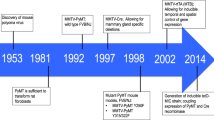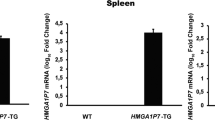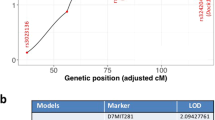Abstract
The inactivation of certain tumor suppressor genes is thought to play an important role in the genesis of a number of tumor types. For example, inactivation of the Retinoblastoma (Rb) tumor suppressor is frequently observed in a proportion of sporadic human breast cancers. While these studies suggest that inactivation of key tumor suppressor genes may play an important role in the induction of mammary cancers, direct evidence supporting this contention is lacking. Because polyomavirus (PyV) Large T (LT) antigen is known to associate with and inactivate certain members of the Rb family (p105Rb, p107, p130), we have derived transgenic mice which express PyV LT antigen in the mammary epithelium. As expected mammary epithelial-specific expression of PyV LT antigen resulted in the induction of mammary tumors which correlated with their capacity to associate with Rb family members. In addition to mammary carcinomas, female transgenic mice expressing the PyV LT transgene frequently develop uterine leiomyomas. Because loss of heterozygosity involving the human CUTL1 (Cut like 1) gene located at chromosomal position 7q22 has been recently implicated in sporadic human uterine leiomyomas, we tested the hypothesis that PyV LT antigen may also form specific complexes with CUTL1. The results of these analyses revealed that specific complexes of CUTL1 and PyV LT antigen could be detected in both leiomyomas and mammary tumors. Taken together, these observations suggest that PyV LT antigen may be involved in inducing these tumors by sequestering both CUTL1 and Rb growth regulatory proteins.
This is a preview of subscription content, access via your institution
Access options
Subscribe to this journal
Receive 50 print issues and online access
$259.00 per year
only $5.18 per issue
Buy this article
- Purchase on Springer Link
- Instant access to full article PDF
Prices may be subject to local taxes which are calculated during checkout
Similar content being viewed by others
Author information
Authors and Affiliations
Rights and permissions
About this article
Cite this article
Webster, M., Martin-Soudant, N., Nepveu, A. et al. The induction of uterine leiomyomas and mammary tumors in transgenic mice expressing polyomavirus (PyV) large T (LT) antigen is associated with the ability of PyV LT antigen to form specific complexes with retinoblastoma and CUTL1 family members. Oncogene 16, 1963–1972 (1998). https://doi.org/10.1038/sj.onc.1201707
Received:
Revised:
Accepted:
Published:
Issue Date:
DOI: https://doi.org/10.1038/sj.onc.1201707
Keywords
This article is cited by
-
BK polyomavirus infection promotes growth and aggressiveness in bladder cancer
Virology Journal (2020)
-
PLCγ contributes to metastasis of in situ-occurring mammary and prostate tumors
Oncogene (2007)
-
Human Cripto-1 overexpression in the mouse mammary gland results in the development of hyperplasia and adenocarcinoma
Oncogene (2005)
-
Refined mapping of the region of loss of heterozygosity on the long arm of chromosome 7 in human breast cancer defines the location of a second tumor suppressor gene at 7q22 in the region of the CUTL1 gene
Oncogene (1999)



